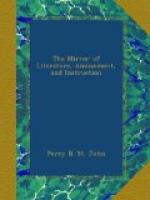I conjure you by that which you profess, (Howe’er you come to know it,) answer me; Though you untie the winds, and let them fight Against the churches—though the yesty waves Confound and swallow navigation up— Though bladed corn be lodg’d, and trees blown down— Though castles topple on their warder’s heads— Though palaces and pyramids do slope Their heads to their foundations—though the treasure Of nature’s germins tumble all together, Even till destruction sicken, answer me To what I ask you. SHAKSPEARE.
In our two preceding papers,[1] we have briefly brought before the attention of the reader, a few of the most prominent and striking features connected with the history of the first (as the honourable house hath it in 1602) “of those detestable slaves of the devil, witches, sorcerers, enchanters and conjurors.” And now we proceed to offer a few concluding illustrations of the subject.
[1] See vol xi. p. 391—vol. xii. p. 70.
In the early ages, to be possessed of a greater degree of learning and science than the mass of mankind (at a time when even kings could not read or write) was to be invested with a more than earthly share of power; and the philosopher was in consequence subjected in many cases to a suspicion at once dangerous and dishonourable: to use the language of Coleridge, the real teachers and discoverers of truth were exposed to the hazard of fire and faggot; a dungeon being the best shrine that was vouchsafed to a Roger Bacon or a Galileo!
A few years since, a place was pointed out to the writer, on the borders of Scotland, which had been even within the “memory of the oldest inhabitant,” used for the “trial” of witches; and a pool of water in an adjacent stream is still to be seen, where the poor old creatures were dragged to sink or swim; and our informant added, that a very great number had perished on that spot. Indeed, in Scotland, a refinement of cruelty was practised in the persecution of witches; the innocent relations of a suspected criminal were tortured in her presence, in the hope of extorting confession from her, in order to put an end to their sufferings, after similar means had been used without effect on herself. Even children of seven years of age were sometimes tortured in the presence of their mothers for this design. In 1751, at Trigg, in Hertfordshire, two harmless old people above seventy years of age, being suspected of bewitching a publican, named Butterfield, a vast concourse of people assembled for the purpose of ducking them, and the poor wretches were seized, and “stripped naked by the mob, their thumbs tied to their toes, and then dragged two miles and thrown into a muddy stream;” the woman expired under the hands of her persecutors, but her husband, though seriously injured, escaped with his life. One of the ringleaders of this atrocious outrage, was tried and hung for the offence.




